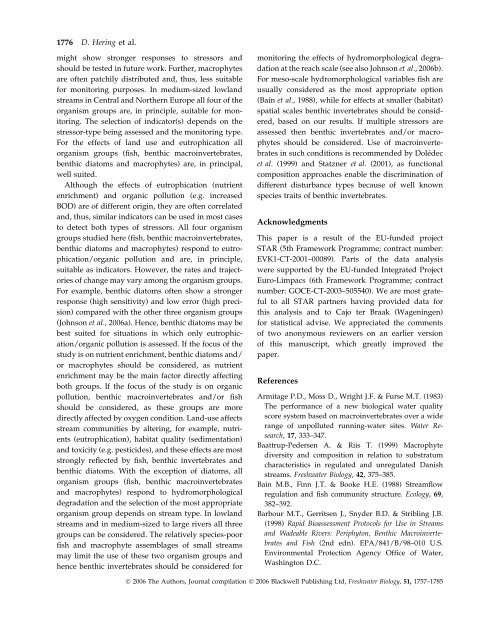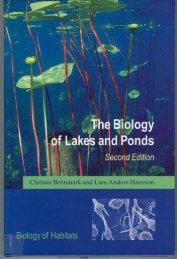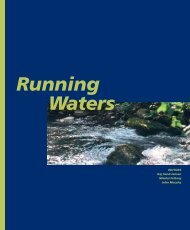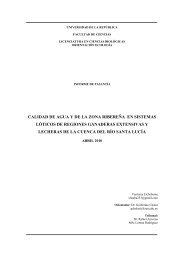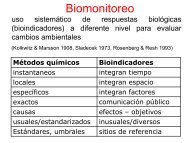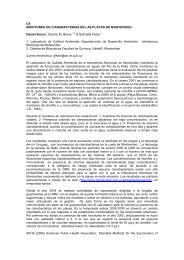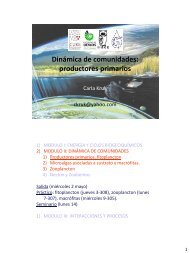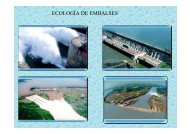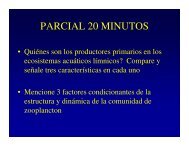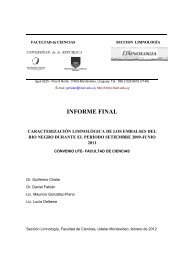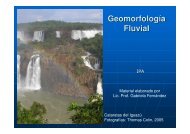Assessment of European streams with diatoms, macrophytes ...
Assessment of European streams with diatoms, macrophytes ...
Assessment of European streams with diatoms, macrophytes ...
Create successful ePaper yourself
Turn your PDF publications into a flip-book with our unique Google optimized e-Paper software.
1776 D. Hering et al.<br />
might show stronger responses to stressors and<br />
should be tested in future work. Further, <strong>macrophytes</strong><br />
are <strong>of</strong>ten patchily distributed and, thus, less suitable<br />
for monitoring purposes. In medium-sized lowland<br />
<strong>streams</strong> in Central and Northern Europe all four <strong>of</strong> the<br />
organism groups are, in principle, suitable for monitoring.<br />
The selection <strong>of</strong> indicator(s) depends on the<br />
stressor-type being assessed and the monitoring type.<br />
For the effects <strong>of</strong> land use and eutrophication all<br />
organism groups (fish, benthic macroinvertebrates,<br />
benthic <strong>diatoms</strong> and <strong>macrophytes</strong>) are, in principal,<br />
well suited.<br />
Although the effects <strong>of</strong> eutrophication (nutrient<br />
enrichment) and organic pollution (e.g. increased<br />
BOD) are <strong>of</strong> different origin, they are <strong>of</strong>ten correlated<br />
and, thus, similar indicators can be used in most cases<br />
to detect both types <strong>of</strong> stressors. All four organism<br />
groups studied here (fish, benthic macroinvertebrates,<br />
benthic <strong>diatoms</strong> and <strong>macrophytes</strong>) respond to eutrophication/organic<br />
pollution and are, in principle,<br />
suitable as indicators. However, the rates and trajectories<br />
<strong>of</strong> change may vary among the organism groups.<br />
For example, benthic <strong>diatoms</strong> <strong>of</strong>ten show a stronger<br />
response (high sensitivity) and low error (high precision)<br />
compared <strong>with</strong> the other three organism groups<br />
(Johnson et al., 2006a). Hence, benthic <strong>diatoms</strong> may be<br />
best suited for situations in which only eutrophication/organic<br />
pollution is assessed. If the focus <strong>of</strong> the<br />
study is on nutrient enrichment, benthic <strong>diatoms</strong> and/<br />
or <strong>macrophytes</strong> should be considered, as nutrient<br />
enrichment may be the main factor directly affecting<br />
both groups. If the focus <strong>of</strong> the study is on organic<br />
pollution, benthic macroinvertebrates and/or fish<br />
should be considered, as these groups are more<br />
directly affected by oxygen condition. Land-use affects<br />
stream communities by altering, for example, nutrients<br />
(eutrophication), habitat quality (sedimentation)<br />
and toxicity (e.g. pesticides), and these effects are most<br />
strongly reflected by fish, benthic invertebrates and<br />
benthic <strong>diatoms</strong>. With the exception <strong>of</strong> <strong>diatoms</strong>, all<br />
organism groups (fish, benthic macroinvertebrates<br />
and <strong>macrophytes</strong>) respond to hydromorphological<br />
degradation and the selection <strong>of</strong> the most appropriate<br />
organism group depends on stream type. In lowland<br />
<strong>streams</strong> and in medium-sized to large rivers all three<br />
groups can be considered. The relatively species-poor<br />
fish and macrophyte assemblages <strong>of</strong> small <strong>streams</strong><br />
may limit the use <strong>of</strong> these two organism groups and<br />
hence benthic invertebrates should be considered for<br />
monitoring the effects <strong>of</strong> hydromorphological degradation<br />
at the reach scale (see also Johnson et al., 2006b).<br />
For meso-scale hydromorphological variables fish are<br />
usually considered as the most appropriate option<br />
(Bain et al., 1988), while for effects at smaller (habitat)<br />
spatial scales benthic invertebrates should be considered,<br />
based on our results. If multiple stressors are<br />
assessed then benthic invertebrates and/or <strong>macrophytes</strong><br />
should be considered. Use <strong>of</strong> macroinvertebrates<br />
in such conditions is recommended by Dolédec<br />
et al. (1999) and Statzner et al. (2001), as functional<br />
composition approaches enable the discrimination <strong>of</strong><br />
different disturbance types because <strong>of</strong> well known<br />
species traits <strong>of</strong> benthic invertebrates.<br />
Acknowledgments<br />
This paper is a result <strong>of</strong> the EU-funded project<br />
STAR (5th Framework Programme; contract number:<br />
EVK1-CT-2001–00089). Parts <strong>of</strong> the data analysis<br />
were supported by the EU-funded Integrated Project<br />
Euro-Limpacs (6th Framework Programme; contract<br />
number: GOCE-CT-2003–505540). We are most grateful<br />
to all STAR partners having provided data for<br />
this analysis and to Cajo ter Braak (Wageningen)<br />
for statistical advise. We appreciated the comments<br />
<strong>of</strong> two anonymous reviewers on an earlier version<br />
<strong>of</strong> this manuscript, which greatly improved the<br />
paper.<br />
References<br />
Armitage P.D., Moss D., Wright J.F. & Furse M.T. (1983)<br />
The performance <strong>of</strong> a new biological water quality<br />
score system based on macroinvertebrates over a wide<br />
range <strong>of</strong> unpolluted running-water sites. Water Research,<br />
17, 333–347.<br />
Baattrup-Pedersen A. & Riis T. (1999) Macrophyte<br />
diversity and composition in relation to substratum<br />
characteristics in regulated and unregulated Danish<br />
<strong>streams</strong>. Freshwater Biology, 42, 375–385.<br />
Bain M.B., Finn J.T. & Booke H.E. (1988) Streamflow<br />
regulation and fish community structure. Ecology, 69,<br />
382–392.<br />
Barbour M.T., Gerritsen J., Snyder B.D. & Stribling J.B.<br />
(1998) Rapid Bioassessment Protocols for Use in Streams<br />
and Wadeable Rivers: Periphyton, Benthic Macroinvertebrates<br />
and Fish (2nd edn). EPA/841/B/98–010 U.S.<br />
Environmental Protection Agency Office <strong>of</strong> Water,<br />
Washington D.C.<br />
Ó 2006 The Authors, Journal compilation Ó 2006 Blackwell Publishing Ltd, Freshwater Biology, 51, 1757–1785


